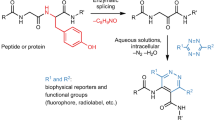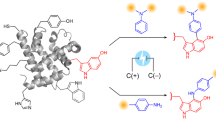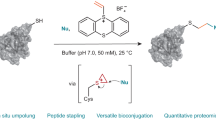Abstract
Selenocysteine (Sec; U in one-letter code) is the twenty-first naturally occurring amino acid, with a selenium atom that gives this cysteine (Cys) homolog unique biochemical properties, including a high nucleophilicity and significant reactivity with electrophilic agents. This can be used in biotechnological Sec-dependent applications. Here, we describe how Sec can be introduced into a carboxy-terminal tetrapeptide motif (-Gly-Cys-Sec-Gly-COOH, known as a Sel-tag) for recombinant proteins by tailoring the encoding gene to become compatible with the Escherichia coli selenoprotein synthesis machinery. We also describe how the Sel-tag can be used as a basis for efficient one-step protein purification, rapid Sec-targeting protein labeling with electrophilic compounds, or radiolabeling with the positron emitter 11C.
This is a preview of subscription content, access via your institution
Access options
Subscribe to this journal
Receive 12 print issues and online access
$259.00 per year
only $21.58 per issue
Buy this article
- Purchase on Springer Link
- Instant access to full article PDF
Prices may be subject to local taxes which are calculated during checkout







Similar content being viewed by others
References
Böck, A. et al. Selenocysteine: the 21st amino acid. Mol. Microbiol. 5, 515–520 (1991).
Arnér, E.S.J. Recombinant expression of mammalian selenocysteine-containing thioredoxin reductase and other selenoproteins in Escherichia coli. Methods Enzymol. 347, 226–235 (2002).
Arnér, E.S.J. et al. High-level expression in Escherichia coli of selenocysteine-containing rat thioredoxin reductase utilizing gene fusions with engineered bacterial-type SECIS elements and co-expression with the selA, selB and selC genes. J. Mol. Biol. 292, 1003–1016 (1999).
Johansson, L. et al. Exploiting the 21st amino acid-purifying and labeling proteins by selenolate targeting. Nat. Methods 1, 61–66 (2004).
Lee, S.R. et al. Mammalian thioredoxin reductase: oxidation of the C-terminal cysteine/selenocysteine active site forms a thioselenide, and replacement of selenium with sulfur markedly reduces catalytic activity. Proc. Natl. Acad. Sci. USA 97, 2521–2526 (2000).
Zhong, L., Arnér, E.S.J. & Holmgren, A. Structure and mechanism of mammalian thioredoxin reductase: the active site is a redox-active selenolthiol/selenenylsulfide formed from the conserved cysteine-selenocysteine sequence. Proc. Natl. Acad. Sci. USA 97, 5854–5859 (2000).
Johansson, L., Gafvelin, G. & Arnér, E.S. Selenocysteine in proteins-properties and biotechnological use. Biochim. Biophys. Acta 1726, 1–13 (2005).
Rengby, O. et al. Assessment of production conditions for efficient use of Escherichia coli in high-yield heterologous recombinant selenoprotein synthesis. Appl. Environ. Microbiol. 70, 5159–5167 (2004).
Kalef, E., Walfish, P.G. & Gitler, C. Arsenical-based affinity chromatography of vicinal dithiol-containing proteins: purification of L1210 leukemia cytoplasmic proteins and the recombinant rat c-erb A beta 1 T3 receptor. Anal. Biochem. 212, 325–334 (1993).
Müller, S. Design neuer Selenoproteine. Thesis (1997).
Chung, C.T., Niemela, S.L. & Miller, R.H. One-step preparation of competent Escherichia coli: transformation and storage of bacterial cells in the same solution. Proc. Natl. Acad. Sci. USA 86, 2172–2175 (1989).
Müller, S., Heider, J. & Böck, A. The path of unspecific incorporation of selenium in Escherichia coli. Arch. Microbiol. 168, 421–427 (1997).
Johansson, L. et al. A mouse model for in vivo tracking of the major dust mite allergen Der p 2 after inhalation. FEBS J. 272, 3449–3460 (2005).
Stone-Elander, S. et al. 11C-labeled 4-isopropylantipyrine: preparation and biological evaluation as a blood flow tracer in positron emission tomography (PET). J. Med. Chem. 28, 1325–1328 (1985).
Schmitt, J., Hess, H. & Stunnenberg, H.G. Affinity purification of histidine-tagged proteins. Mol. Biol. Rep. 18, 223–230 (1993).
Smith, D.B. & Johnson, K.S. Single-step purification of polypeptides expressed in Escherichia coli as fusions with glutathione S-transferase. Gene 67, 31–40 (1988).
Riggs, P. Expression and purification of recombinant proteins by fusion to maltose-binding protein. Mol. Biotechnol. 15, 51–63 (2000).
Chalfie, M. et al. Green fluorescent protein as a marker for gene expression. Science 263, 802–805 (1994).
Adams, S.R. New biarsenical ligands and tetracysteine motifs for protein labeling in vitro and in vivo: synthesis and biological applications. J. Am. Chem. Soc. 124, 6063–6076 (2002).
Griffin, B.A., Adams, S.R. & Tsien, R.Y. Specific covalent labeling of recombinant protein molecules inside live cells. Science 281, 269–272 (1998).
Turton, D.R. et al. Preparation of human serum [methyl-11C]methylalbumin microspheres and human serum [methyl-11C]methylalbumin for clinical use. Int. J. Appl. Radiat. Isot. 35, 337–344 (1984).
Westerberg, G. & Langstrom, B. Labelling of proteins with 11C in high specific radioactivity: [11C]albumin and [11C]transferrin. Appl. Radiat. Isot. 45, 773–782 (1994).
Hu, V.W., Heikka, D.S., Dieffenbach, P.B. & Ha, L. Metabolic radiolabeling: experimental tool or Trojan horse? 35S-Methionine induces DNA fragmentation and p53-dependent ROS production. FASEB J. 15, 1562–1568 (2001).
Acknowledgements
The authors are grateful to all of our collaborators in the original studies as cited herein. The work in the laboratories of the authors is supported by Karolinska Institutet, the Swedish Cancer Society, the Swedish Research Council and the European Union.
Author information
Authors and Affiliations
Corresponding author
Ethics declarations
Competing interests
The authors declare no competing financial interests.
Rights and permissions
About this article
Cite this article
Cheng, Q., Stone-Elander, S. & Arnér, E. Tagging recombinant proteins with a Sel-tag for purification, labeling with electrophilic compounds or radiolabeling with 11C. Nat Protoc 1, 604–613 (2006). https://doi.org/10.1038/nprot.2006.87
Published:
Issue Date:
DOI: https://doi.org/10.1038/nprot.2006.87
This article is cited by
Comments
By submitting a comment you agree to abide by our Terms and Community Guidelines. If you find something abusive or that does not comply with our terms or guidelines please flag it as inappropriate.



